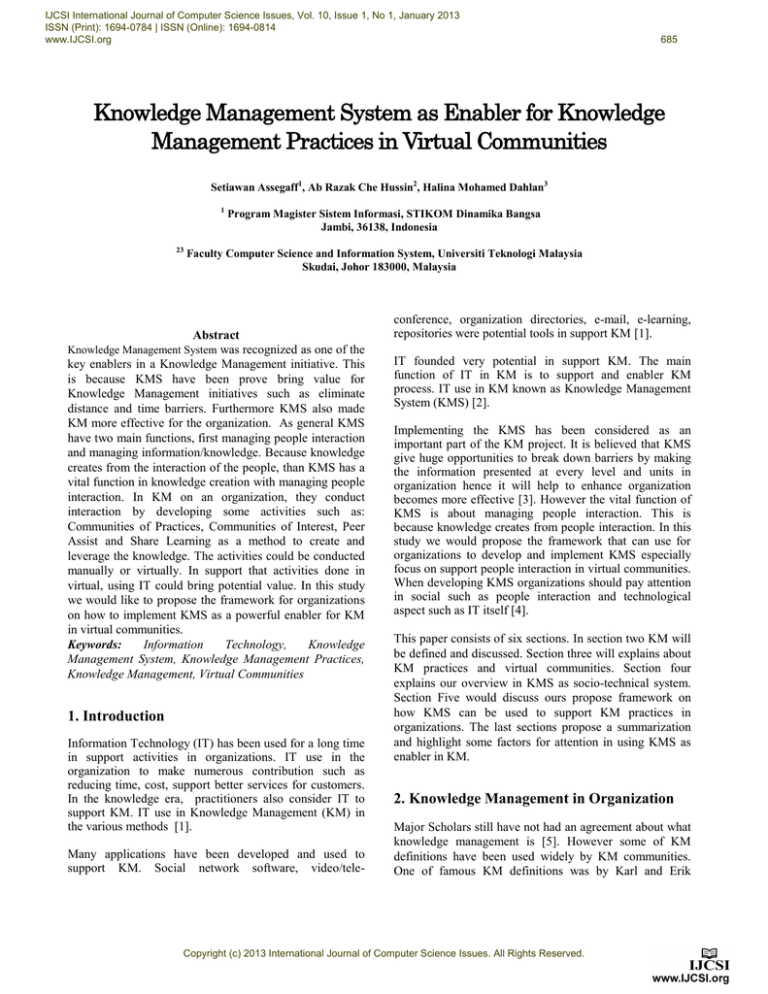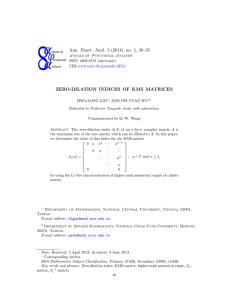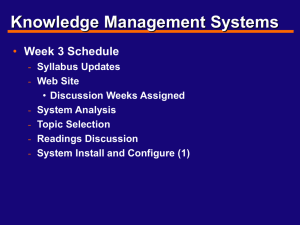Knowledge Management System as Enabler for Knowledge
advertisement

IJCSI International Journal of Computer Science Issues, Vol. 10, Issue 1, No 1, January 2013 ISSN (Print): 1694-0784 | ISSN (Online): 1694-0814 www.IJCSI.org 685 Knowledge Management System as Enabler for Knowledge Management Practices in Virtual Communities Setiawan Assegaff1, Ab Razak Che Hussin2, Halina Mohamed Dahlan3 1 23 Program Magister Sistem Informasi, STIKOM Dinamika Bangsa Jambi, 36138, Indonesia Faculty Computer Science and Information System, Universiti Teknologi Malaysia Skudai, Johor 183000, Malaysia Abstract Knowledge Management System was recognized as one of the key enablers in a Knowledge Management initiative. This is because KMS have been prove bring value for Knowledge Management initiatives such as eliminate distance and time barriers. Furthermore KMS also made KM more effective for the organization. As general KMS have two main functions, first managing people interaction and managing information/knowledge. Because knowledge creates from the interaction of the people, than KMS has a vital function in knowledge creation with managing people interaction. In KM on an organization, they conduct interaction by developing some activities such as: Communities of Practices, Communities of Interest, Peer Assist and Share Learning as a method to create and leverage the knowledge. The activities could be conducted manually or virtually. In support that activities done in virtual, using IT could bring potential value. In this study we would like to propose the framework for organizations on how to implement KMS as a powerful enabler for KM in virtual communities. Keywords: Information Technology, Knowledge Management System, Knowledge Management Practices, Knowledge Management, Virtual Communities 1. Introduction Information Technology (IT) has been used for a long time in support activities in organizations. IT use in the organization to make numerous contribution such as reducing time, cost, support better services for customers. In the knowledge era, practitioners also consider IT to support KM. IT use in Knowledge Management (KM) in the various methods [1]. Many applications have been developed and used to support KM. Social network software, video/tele- conference, organization directories, e-mail, e-learning, repositories were potential tools in support KM [1]. IT founded very potential in support KM. The main function of IT in KM is to support and enabler KM process. IT use in KM known as Knowledge Management System (KMS) [2]. Implementing the KMS has been considered as an important part of the KM project. It is believed that KMS give huge opportunities to break down barriers by making the information presented at every level and units in organization hence it will help to enhance organization becomes more effective [3]. However the vital function of KMS is about managing people interaction. This is because knowledge creates from people interaction. In this study we would propose the framework that can use for organizations to develop and implement KMS especially focus on support people interaction in virtual communities. When developing KMS organizations should pay attention in social such as people interaction and technological aspect such as IT itself [4]. This paper consists of six sections. In section two KM will be defined and discussed. Section three will explains about KM practices and virtual communities. Section four explains our overview in KMS as socio-technical system. Section Five would discuss ours propose framework on how KMS can be used to support KM practices in organizations. The last sections propose a summarization and highlight some factors for attention in using KMS as enabler in KM. 2. Knowledge Management in Organization Major Scholars still have not had an agreement about what knowledge management is [5]. However some of KM definitions have been used widely by KM communities. One of famous KM definitions was by Karl and Erik Copyright (c) 2013 International Journal of Computer Science Issues. All Rights Reserved. IJCSI International Journal of Computer Science Issues, Vol. 10, Issue 1, No 1, January 2013 ISSN (Print): 1694-0784 | ISSN (Online): 1694-0814 www.IJCSI.org 686 Sveiby. They defined KM as: Knowledge management is creating value by leveraging intangible assets. support the communities. Table 1 bellow explain the activities interaction among communities. We highlight there are three important components in KM is about; first, is about managing people, it related with at networking; collaboration; the second is about managing knowledge/information, it is related to accessibility, searching, validating, taxonomy, up-to date, knowledge flooding and Managing Information technology is related with information/ knowledge security, speed, and reliability Table 1. KM Practices in Organization Knowledge is created when interaction among people in an organization occurs. Nonaka believed that an organization can create and utilizes knowledge through converting tacit knowledge, and vice versa. He proposes SECI model to figure four modes of knowledge conversion [6], which can be described follows; four modes of knowledge conversion were identified: 1. Tacit to Tacit (Socialization) - This dimension explains Social interaction as tacit to tacit knowledge transfer, sharing tacit knowledge through face-to-face or share knowledge through experiences. 2. Tacit to Explicit (Externalization) - Between tacit and explicit knowledge by Externalization (publishing, articulating knowledge), which embed the combined tacit knowledge which enable its communication. 3. Explicit to Explicit (Combination) - Explicit to explicit by Combination (organizing, integrating knowledge), combining different types of explicit knowledge, for example building prototypes. 4. Explicit to Tacit (Internalization) - Explicit to tacit by Internalization (knowledge receiving an application by an individual), enclosed by learning by doing; on the other hand, explicit knowledge becomes part of an individual's knowledge and will be assets for an organization. 3. Knowledge Management Practices and Virtual Communities in Organization KM has been recognized by organizations for decades. On many KM implementations, most of the organizations focus their KM on knowledge creation and how it can leverage in their organization [6]. To achieve that, some methods and roles have been developed. One of successful methods was by creating interaction among people in communities. Communities had proven as powerful entities could use by organizations for knowledge creation and knowledge leverage [7]. Some of communities interaction could develop in a KM initiative in an organization such as: Community of interest (CoI), Community of Practices (CoP), Share Learning (SL), Project Retrospective (PR), and Peer Assist (PA). Beside that an organization could implement knowledge repositories and expert locator to From that activity, knowledge have been created and leveraged. Each activities base on communities have their own benefits and characteristics. For example CoI is best for organization in getting idea from communities furthermore Peer assists give opportunity for a team project to learn from their senior. All of the activities above are about people interaction. It is important for organizations to clearly understand the benefit and values from each community activities and decide the best activities they could develop for their KM. The concepts of community activities itself is relevant to the SECI model of Nonaka. SECI Model describes people interaction and how knowledge could create and leverage in some different activities. In SECI model is merely about socialization aspect. Nowadays with support of technologies the activities could conduct in virtual way known as virtual communities [1]. Virtual communities consist of a large number of people, who is connecting each others in the internet and exchange views on specific subjects. Virtual communities are similar to virtual organizations (VO) in many aspects. [8]. Both, VOs as well as communities need support for information sharing, for communication and for sharing of resources across organizational borders [9] Support for virtual communities by using collaboration and knowledge management application base on web technology has to meet several challenges. Firstly, communication between the community members has to be improved to reduce the geographical and cultural distances. Secondly, simplified and effective sharing of knowledge has to be enabled. A structured knowledge base is an important step in (re) as common knowledge. Thirdly, management of a community has to be simplified. The goal of virtual communities is about communication and collaboration [9]. Copyright (c) 2013 International Journal of Computer Science Issues. All Rights Reserved. IJCSI International Journal of Computer Science Issues, Vol. 10, Issue 1, No 1, January 2013 ISSN (Print): 1694-0784 | ISSN (Online): 1694-0814 www.IJCSI.org 687 4. Knowledge Management System Information technology used in KM known as Knowledge Management System (KMS). In common, Knowledge Management Systems (KMS) are IT that enables organizations to manage effective and efficient knowledge. Some definition of KMS has been proposed by some researchers. One of widely use is the KMS definition of Alavi and Leidner [3] . They defined KMS as a class of information systems applied for managing organizational knowledge. Another perspective of KMS comes from Ericsson, F. & Avdic, A. (2004). They defined KMS as a system that increase organizatinal performance by increase the better decision by employee when they use knowledge in daily work activities [10]. Fig 2. SECI link to KMS Function Figure 2 above describes how KMS function has potential aspect to enable KM initiatives. KMS has In fact, the KMS have a great opportunity to support KM in organizations [14]. KMS has many opportunities to bring benefit in KM such as KMS could help people to connect with the right people, in example if an engineering face a problem in his/her job he/she can use IT tool in KMS to find expert easier compare if he/she do in manual. Fig 1. KMS Function From the definition of function KMS above, we have highlighted two of the elements that should exist in KMS. First KMS should have ability to connecting people, its mean by hardware and software KMS enable people to support interaction among people in communities, communicate with them and making collaboration. Another KMS function is to manage information/knowledge in order help people to reuse knowledge and make better decision with their knowledge [13]. Figure 2 above describes the function of KMS as general However some aspect should identify carefully when organizations have a plane to decide what type of KMS to support their KM activities. If the organization focus on a specific kind of their knowledge, it is better for them to develop KMS in very specific function [5], otherwise they could develop KM in general function. In this case KMS would have all functions such as managing people interaction and managing knowledge/information. To help organizations aim their goal in developing and implemented KMS. We propose a framework to guide them what aspects they should carefully attend and awareness in KMS. Figure 3 below describes our framework. 5. KMS as Enabler In KM. IT is enabler of human-based methodology. Most of KM reseachers agree that knowledge does not exist in technical elements-they only exist in human beings who are able to act upon the knowledge [4]. Therefore, no technology by itself couldl be exist for the creation and leveraging of knowledge assets without integration and tailored to the needs of specific communities of people. SECI model is very good to describe the proces in knowledge creation and how it could be leverage by people [6]. Fig 3. KMS as Enabler for KM Practices in Virtual Communities Copyright (c) 2013 International Journal of Computer Science Issues. All Rights Reserved. IJCSI International Journal of Computer Science Issues, Vol. 10, Issue 1, No 1, January 2013 ISSN (Print): 1694-0784 | ISSN (Online): 1694-0814 www.IJCSI.org The aspects that organizations should also consider when develop KMS such as: KMS today is about web technology and the environment. People have a chance to interact each other as virtual. Some trend in virtual communities in the KM base on web technology are Virtual CoP, Virtual CoI and Virtual Peer Assist. Some research has identified in virtual community factors like trust is becoming a very important issue [11]. When organization decides to conduct virtual communities they must careful attention to the issues beside technology part, In fact, the manual procedure to conduct virtual communities should develop [12]. [7] [8] [9] [10] [11] 6. Conclusions KMS has great opportunity as enable for virtual communities in KM. The organization should pay attention both in social and technological aspect when develop and implement KMS. As general KMS have two functions: managing people interaction and managing knowledge/information. The organization should carefully decide what type of KMS they should adapt. Each of KMS has different treatments and factors for attention. The right decision of choosing tools for support and enabler KM practices in an organization is critical and would impact the benefit of KM process. [12] [13] [14] 688 E. Wenger, "Knowledge management as a doughnut: Shaping your knowledge strategy through communities of practice," Ivey Business Journal Online, vol. January/February, 2004. D. Langenberg, et al., " Knowledge Management in Cloud Environments " I-KNOW Conference 2011. v. D. Langenberg and M. Welker, "Knowledge management in virtual communities," Open Journal of Knowledge Management, 16. Mai 2011. F. Ericsson and A. Avdic, "Knowledge Management Systems Acceptance," Knowledge Management: Current Issues and Challenges, pp. (Pp. 39-51), 2003. A. Alexander, et al., "Motivation and barriers to participation in virtual knowledge-sharing communities of practice," Journal of Knowledge Management, vol. 7, pp. 64-77, 2003. J. Li, et al., "Exploring the Contribution of Virtual Worlds to Learning in Organizations," Human Resource Development Review, vol. 10, pp. 264-285, September 1, 2011. D. V. Subramanian and A. Geetha, "Evaluation Strategy for Ranking and Rating of Knowledge Sharing Portal Usability," IJCSI International Journal of Computer Science Issues, Vol. 9, 2012. ARC Hussin and Setiawan Assegaff, “Knowledge Management System as Socio-Technical System”, IJCSI International Journal of Computer Science Issues, Vol. 9, 2012. References [1] [2] [3] [4] [5] [6] I. Ajiferuke and A. Markus, ". . Potentials of Information Technology in Building Virtual Communities," in Encyclopedia of Multimedia Technology and Networking, I. M. P. (Ed.), Ed., Ed. Hershey: PA: Information Science Reference, 2005, pp. (Pp. 836-841). R. McDermott, "Why Information Technology Inspired But Cannot Deliver Knowledge Management," California Management Review, vol. 41, 1999. M. Alavi and D. E. Leidner, "Review: Knowledge Management and Knowledge Management Systems Conceptual Foundations and Research Issues," MIS Quarterly vol. 25 (1), pp. 107-136, 2001. M. Jelavic, "Socio-Technical Knowledge Management and Epistemological Paradigms: Theoretical Connections at the Individual and Organisational Level," Interdisciplinary Journal of Information, Knowledge, and Management vol. Volume 6, 2011. Hansen, et al., "Whatʼs your strategy for managing knowledge? Harvard Business Review,". Taylor \& Francis, vol. 77(2), 106-116, 187, (1999). I. Nonaka, "A Dynamic Theory of Organizational Knowledge Creation," Organization Science, vol. Vol. 5, No. 1, pp. 14-37, 1994. Setiawan Assegaff is a PhD candidate at the Faculty of Computer Science and Information System, University Teknologi Malaysia. His education includes BS and MS in Information System, University of Gunadrma, Indonesia in 2000 and 2003. His research interests focus on Knowledge Management, Technology Adoption and Computer and Society. Ab Razak Che Hussin is a senior lecturer in Faculty of Computer Science and Information System, Universiti Teknologi Malaysia. He received his PhD from University of Manchester in 2006 on the field of Trust in E-commerce. His research interests focus on information system, web application and trust and privacy in e-commerce. Halina Mohamed Dahlan is a senior lecturer in Faculty of Computer Science and Information System, Universiti Teknologi Malaysia. She received his PhD from University of Manchester in 2008 on the field of Intelligent Decision Support. Her research interests focus on business intelligent, evolutionary computing, and fuzzy logic. Copyright (c) 2013 International Journal of Computer Science Issues. All Rights Reserved.




